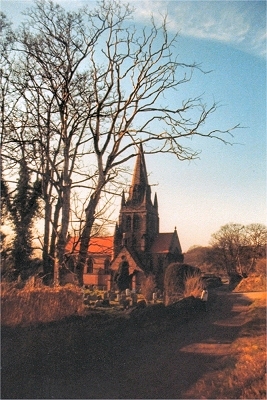 |
St. Bartholomew's Church, Thurstaston
A timeless setting in the tiny hamlet of Thurstaston. There have definitely been two earlier churches here and possibly a further one in Saxon times. The first was Norman, dating from 1125 or earlier. In 1724 this was described as being a 'mean building extremely small, low and dark'. It was demolished in 1820 and nothing remains of it. The second church of 1824, also an undistinguished structure, was pulled down except for the tower to prepare for the current sandstone church, completed 1886. The tower of the second church is still standing and the rest of the stone was used to build the churchyard wall. |
 |
 |
The Old Church Tower, Thurstaston
This tower all that remains of Thurstaston's earlier church of 1824, the rest pulled down to prepare for the current church of 1886. |
 |
 |
Thurstaston Hall
The central block of Thurstaston Hall dates from around 1680, though the origins of a manor house here can be traced back to about 1070. The entrance might be older than the rest, possibly 1350. The Elizabethan-styled east wing, partly visible on the left, was built in 1836, and the gatepiers are of 1733. The Pevsner Guide notes 'a charming appearance, tranquil and mellow'. |
 |
 |
The West Wing, Thurstaston Hall
The west wing of Thurstaston Hall is 15th century or earlier. The extension to the right behind the chimney was remodelled or rebuilt in 1680 according to a datestone, around the same time as the present main block. |
 |
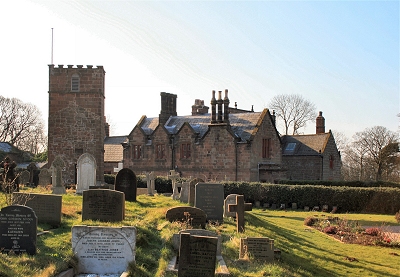 |
Thurstaston Hall and the Old Church Tower |
 |
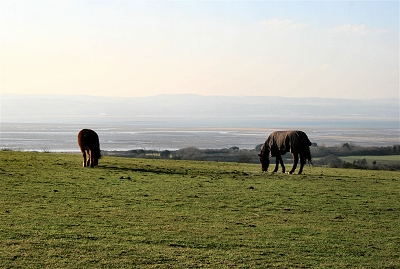 |
Horses on the Wirral Way near Thurstaston |
 |
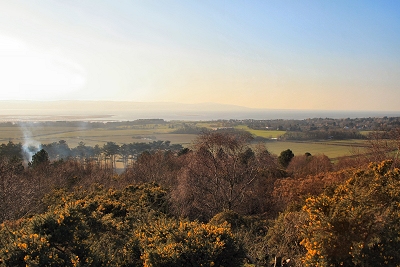 |
View over the River Dee from Thurstaston Hill
Thurstaston Common consists, with the adjacent Royden Park, of 250 acres of heath, woods and parkland, much of it owned by the National Trust. Thurstaston Hill is a rocky sandstone outcrop with magnificent views all around, including the Liverpool skyline, the Welsh hills over the River Dee, the Irish Sea coast and, in clear weather, Snowdonia, the Pennine Hills, the Lake District and (allegedly) the Isle of Man. The hill forms part of Thurstaston Common and is a focus for the many excellent walks in the area. |
 |
 |
Thurstaston Hill Summit
The summit pillar has a direction finding table to help you find your way around the superb panorama. |
 |
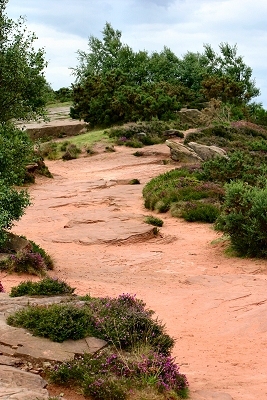 |
Thurstaston Hill
This is the approach to Thurstaston Hill along the ridge from the north side. My thanks to Don Garton for this picture. |
 |
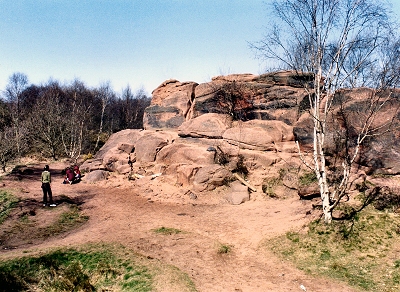 |
Thor's Stone, Thurstaston Common
The origin and name of this isolated block of sandstone have been a target of much fevered romantic imagining, mainly by the Victorians, including it being man-made and used for sacrifices by the Vikings. The likely truth is more prosaic. It seems to have been carved out by water flows under the ice at the end of the last Ice Age and further modified by subsequent erosion and possible quarrying. |
 |
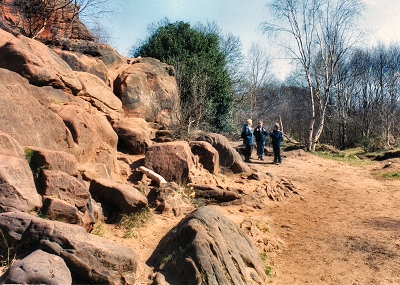 |
Thor's Stone, Thurstaston Common
The top of Thor's Stone can be reached by a choice of easy scrambles up the heavily eroded rock. The outlines of 230 million year old sand dunes can be detected in the rock layers, a reminder that the Merseyside area was an equatorial desert in the Triassic period. |
 |
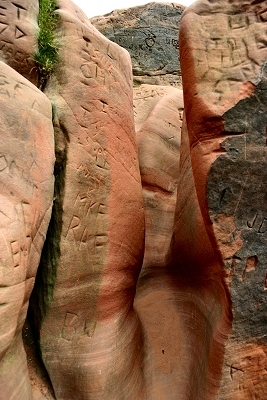 |
Thor's Stone, Thurstaston Common
Detail of the fantastic patterns of erosion on Thor's Stone. My thanks to Don Garton for this picture. |
 |
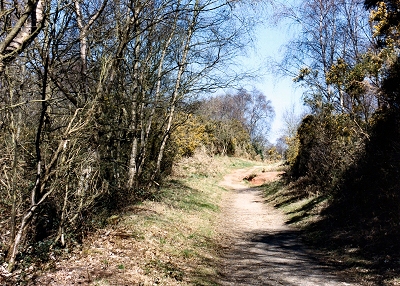 |
Sandy Track, Thurstaston Common
This is typical of the many sandy tracks that criss-cross Thurstaston Common and prove a huge attraction to walkers. |
 |
 |
Hill Bark, Royden Park, Thurstaston
The imposing, if rather tastless, mock-Tudor Hill Bark dates only from 1931, though incredibly enough it was originally built in 1891 as Bidston Court near Bidston Hill for soap magnate R.W. Hudson and moved brick by brick to its current position by Sir Ernest Royden, who gives his name to the surrounding parkland. It stands on the site of an 1865 house of the same name, which in turn stood on the site of an ancient tithebarn. Hill Bark is now a hotel and conference centre, but Royden Park is open to the public and is beautifully laid out with open spaces, woodland and small lakes. |
 |
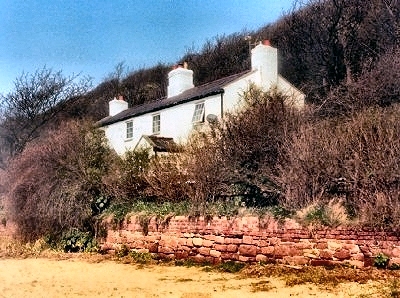 |
Shore Cottage, Thurstaston
Old cottages in a remarkable location on the shore at Thurstaston, just above the waterline. There are the remains of what looks like an old quay here and a pleasant stretch of sand with a little stream. |
 |
 |
Irby Hall
Irby Hall, on the site of an ancient manor house of Chester Abbey, is early 17th century, with some reconstruction in 1888. A high earth bank and the remains of a deep moat are reminders of times when marauding Welshmen were slightly more of a problem than they are today. Recent excavations nearby in Irby have uncovered the remains of a settlement dating from Iron Age and Roman times. |
 |
 |
The Anchor Inn, Irby
The Anchor is one of the oldest buildings in Irby, though internally modernised. |
 |
Irby in Lewis's Topographical Dictionary of England (1848)
Irby Hall is a large fabric of timber and plaster, standing upon the boundary of the two parishes [Thurstaston], and surrounded with ash-trees of great age and size. There are a few good houses in the village, which has a neat and respectable appearance. |
 |
The Irby Mill, Irby
Once the cottage next to the windmill of Irby Mill, this old sandstone pub has bags of character with small cosy rooms, beams, low ceilings and stone floors. |
 |
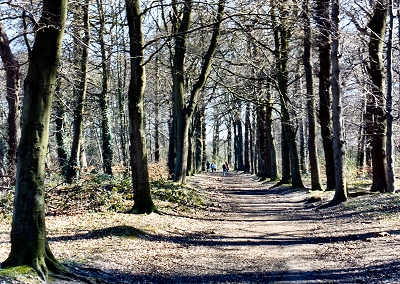 |
Woodland Path, Arrowe Park
Arrowe Country Park consists of 400 acres of fine open parkland, woodland, wildflower meadows, a lake, a brook and a golf course. It is a haven for wildlife, especially birds, butterflies, dragonflies and amphibians. |
 |
